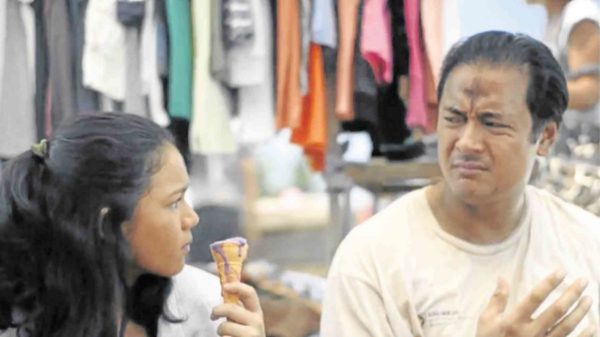
Angellie Sanoy (left) and Allen Dizon in “Bomba”
Starting the year with a bang, three Filipino films got invitations to international festivals in Asia and Europe.
Zig Dulay’s “Bagahe” is headed to three film festivals in Europe. It will have its “international premiere” in France—specifically, at the Vesoul International Film Festival of Asian Cinema, set from Jan. 30 to Feb. 6.
Dulay told the Inquirer: “I am excited to share our film with the entire world. I am looking forward to seeing the reaction of foreigners. They read, see and view films differently.”
He said it’s important for filmmakers to be exposed to international feedback “so that their understanding of cinema will become deeper and broader.”
He noted: “They will see their films’ place not only in their own country but in the wider global context.”
“Bagahe” is also nominated at the London International Film Festival (Feb. 10 to 17): best cinematographer (Albert Banzon), actress (Angeli Bayani), supporting actress (Shamaine Buencamino) and director.
“Bagahe” is also gunning for awards at the Amsterdam International Film Festival in the Netherlands (Aug. 11 to 18): best foreign language film, original screenplay (Dulay), supporting actress (Buencamino), editing (Dulay) and sound design (Andrew Milallos).
“To get noticed in festivals abroad is a big deal,” Dulay remarked. “I’m happy that specific members of the cast and crew have been recognized.”
Meanwhile, two other Filipino films competed at the 16th Pune International Film Festival in India, which ended yesterday.
Sheron Dayoc’s acclaimed “Women of the Weeping River” vied in the World Competition section, while Ralston Jover’s similarly commended “Bomba” is included in the Asian Cinema tilt of the festival.
Frederikke Aspöck’s “Rosita,” a Danish film featuring Filipino actress Mercedes Cabral in the title role, was showcased in the Kaleidoscope program.
The Pune fest aims “to give the region’s film lovers access to global cinema… sparking cultural exchange [in the process].”
Jover related: “I’m thrilled, especially when I saw the lineup that included films by Hong Sang-soo (“The Day After”) and other masters. It’s another validation from the cinema community that our movie deserves a slot in the diverse film culture of Central Asia.”
Dayoc remarked: “I am very glad that our film continues to travel and share our little story with the world. I hope our film continues to shed light on the issues faced by our people in Mindanao. As a filmmaker, this is the only thing I know… to [contribute to] this long journey of creating a better Mindanao. My wish is that the film touches foreign audiences the way it has touched local viewers. We may have different cultures, but we certainly share the same experience of grief and human triumph.”

